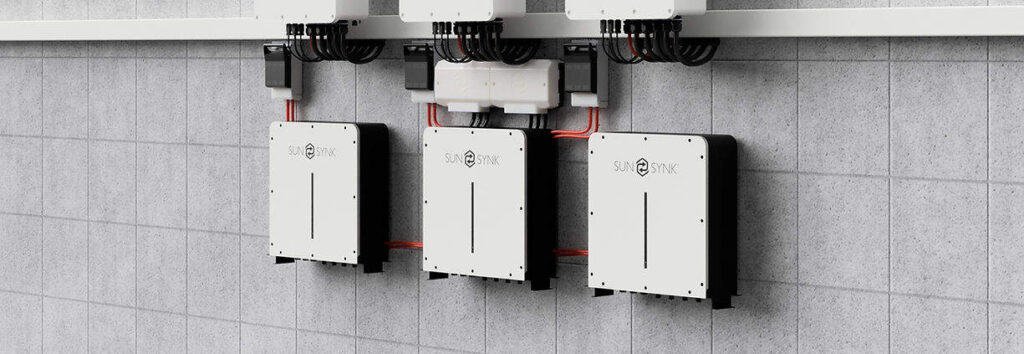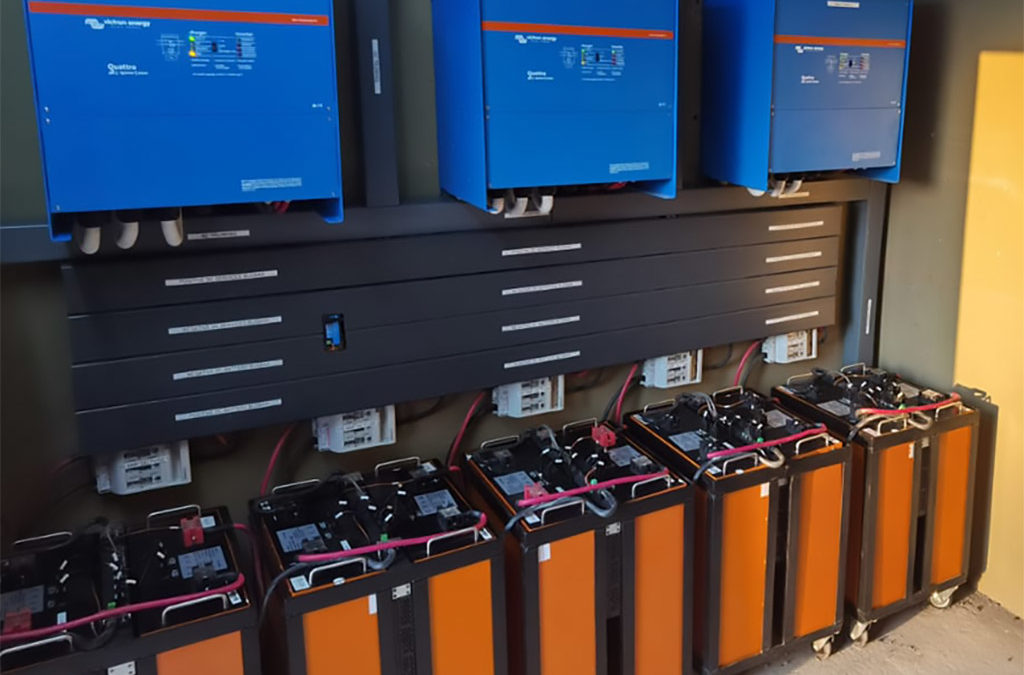Installing and storing solar batteries correctly is crucial to ensuring their optimal performance, longevity, and your safety. Whether for a residential or commercial solar setup, there are specific best practices you should follow.
In this article we share best practices that will maximise the efficiency of your solar battery system, prevent avoidable issues such as capacity loss, and reduce the potential of a fire hazard.
Choose an Ideal Location
Where you install and store your solar batteries plays a critical role in their performance and lifespan. Zimbabwe experiences significant temperature variations, and it’s essential to consider this when selecting a storage location.
Effects of Temperature on Battery Performance
Solar batteries are sensitive to temperature. The ideal storage temperature for most batteries is between 15°C and 25°C.
High temperatures degrade solar battery performance by accelerating the chemical reactions inside, causing overheating, and potentially shortening the battery’s lifespan. This typically starts to occur at temperatures above 30°C to 35°C, depending on the battery type.
Matabeleland North (particularly places like Hwange) and lowveld areas like Chiredzi regularly reach these temperatures during the hot summer months (October to March).
What you should do:
- Install the batteries in well-ventilated, shaded areas.
- Use cooling mechanisms like fans or vents to maintain a stable environment.
- Install the batteries indoors or away from direct sunlight.
Low temperatures slow down the chemical reactions within solar batteries, reducing their charging efficiency and capacity. This typically happens when temperatures drop below 10°C.
Highland areas like Nyanga and the Eastern Highlands experience these low temperatures, especially during winter months (June to August).
What you should do:
- Keep the batteries in insulated or temperature-controlled environments.
- Consider using battery heaters during winter if necessary.
Indoor versus Outdoor Solar Battery Installation
Deciding between indoor and outdoor solar battery installation comes down to several factors including temperature control, security, and, in most cases, the available space.
Indoor Installation
Most residential solar systems feature indoor solar battery installations which come with the following advantages and disadvantages.
Advantages:
- Temperature Control: Indoor spaces generally offer a more controlled environment, protecting batteries from the high summer temperatures and cooler winter nights. This helps in maintaining optimal battery performance and longevity, especially in regions with extreme temperature variations like Hwange or Nyanga.
- Security: Indoors installations offer better protection against theft or vandalism.
- Reduced Weather Exposure: Batteries installed indoors are shielded from harsh weather elements like rain, dust, and direct sunlight, reducing the risk of physical damage.
Disadvantages:
- Ventilation Issues: Poor ventilation in an indoor setting can lead to overheating, especially if the batteries are not installed with proper airflow. This can be a concern in smaller or poorly ventilated rooms.
- Space Requirements: Indoor installation requires dedicated space, which might be a challenge for homes or businesses with limited indoor room.

Solar batteries, particularly lead-acid types, can emit gases such as hydrogen when charging. These gases are highly flammable, making proper ventilation crucial to prevent accumulation in enclosed spaces.
Ensure the room or enclosure where the battery is installed has proper airflow. For lead-acid batteries, install vents to dissipate any gases safely. Lithium-ion batteries don’t emit gases but still require airflow to prevent overheating.
Depending on your location, natural ventilation (windows, vents) might be sufficient, but in more enclosed spaces, forced ventilation using fans may be necessary to maintain air circulation and temperature control.
While the risk of fire is low with modern lithium-ion systems, lead-acid batteries still carry some risk, particularly if they are poorly maintained. Install smoke and heat detectors in rooms where batteries are stored. Keep a fire extinguisher nearby, especially a Class C extinguisher that can handle electrical fires.

Outdoor Installation
Outdoor solar battery installations are less common but they are an option especially where there is no available indoor space. In certain scenarios they are a better option, for example in a garage that’s attached to the home, as this reduces the safety hazard.
Advantages:
- Space-Saving: Installing solar batteries outdoors saves indoor space, which can be useful for businesses or homes with limited indoor capacity.
- Ventilation: Outdoors installations generally have better natural airflow, which can help with cooling in hot regions. Proper outdoor housing ensures batteries remain at optimal temperatures.
Disadvantages:
- Temperature Sensitivity: Zimbabwe experiences both very high temperatures (above 35°C) and low temperatures (below 10°C). Extreme temperatures outdoors can negatively affect battery performance and lifespan if not properly mitigated through weatherproof housing or temperature control mechanisms.
- Security Risks: Batteries installed outdoors are more vulnerable to theft, especially in areas where security infrastructure is limited.
- Exposure to Elements: Outdoor installations require weatherproof enclosures to protect against dust, rain, and sun, increasing the cost and complexity of the installation.
If you must store batteries outside, invest in a weatherproof and temperature-controlled enclosure to protect them from the elements. These enclosures should offer adequate ventilation and keep out dust and moisture.
Mounting and Securing the Battery
Secure mounting and proper positioning can avoid physical damage especially for larger systems. Mounting brackets and enclosures will prevent tipping or falling in the rare event that we do get an earth tremor.
Installers should use appropriate racks or wall mounts that are designed to hold the weight and size of the battery. For lithium-ion batteries, wall-mounted systems are particularly useful in saving space.
For large commercial installations, floor-mounted racks that are vibration-resistant help ensure stability and safety.
While earth tremors are extremely rare in Zimbabwe, it is still good practice to secure batteries against potential movement. This is especially important for lead acid batteries which have a liquid electrolyte that could spill. Lithium batteries do not use a liquid electrolyte but they can still get damaged from falling.
Follow Manufacturer Guidelines
Each type of solar battery comes with specific manufacturer recommendations for installation, storage, and usage. Sticking to these guidelines is essential for preserving warranty coverage and ensuring optimal performance.
Ensure your solar battery is installed according to the manufacturer’s electrical specifications. Overloading or improper wiring can lead to system inefficiencies or even hazards such as fire. Always use the correct cables, connectors, and circuit breakers to prevent voltage drops or power surges. Other helpful guidelines you should follow include:
- Battery Monitoring Systems: Many modern batteries come with built-in monitoring systems to track charge cycles, temperature, and performance. Ensure these systems are properly set up during installation, as they provide valuable data for maintaining the battery over its lifespan.
- Ensure Adequate Protection Against Power Surges: Solar batteries are sensitive to fluctuations in voltage. Installing surge protection devices (SPDs) at key points in your solar setup prevents power surges from damaging your battery or inverter. These surges can happen during thunderstorms, a common occurrence during the rainy season.
- Inverter Compatibility: Make sure the inverter you choose is compatible with your battery. Incompatible inverters can cause inefficient charging, leading to battery wear and reduced performance.
Regular Maintenance and Inspection
To extend the life of your solar battery system, regular maintenance is critical. This is especially true for lead-acid batteries, which require more upkeep than lithium-ion options.
Lead-acid batteries require a fair bit of maintenance. These are the main things you should be doing on a regular basis.
- Check electrolyte levels regularly and top up with distilled water as necessary.
- Keep the terminals clean and free of corrosion, and inspect the casing for cracks or leaks.
- Lead-acid batteries should also be equalised (charged to a higher voltage) periodically to prevent sulfation, which degrades the battery’s capacity.
Lithium-ion batteries require less maintenance, but regular system monitoring is still important. Keep an eye on temperature, charge cycles, and any warnings from the battery’s built-in management system.
Following these best practices for installing and storing solar batteries will ensure optimal system performance and longevity. Proper location selection, ventilation, mounting, and maintenance are all critical steps in safeguarding your investment.
Get in touch with us on Facebook or WhatsApp for expert guidance on installing, troubleshooting and maintaining your solar batteries.